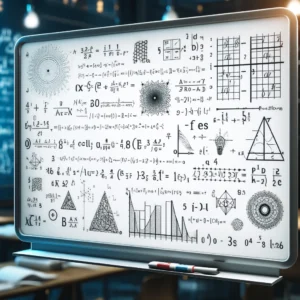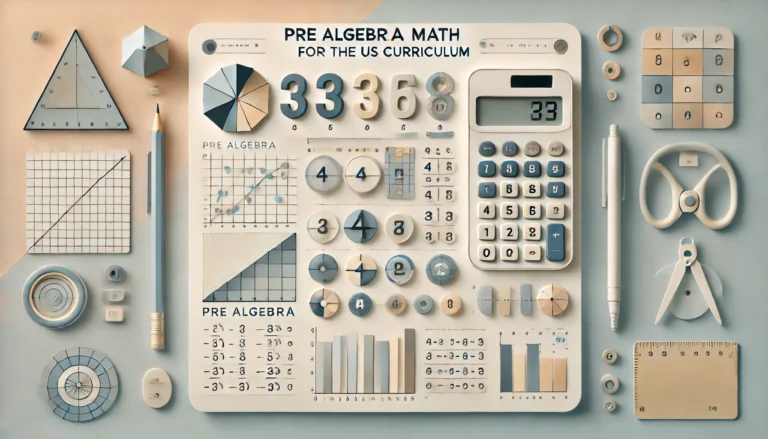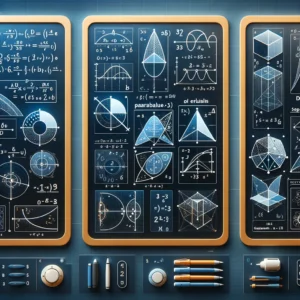Pre Algebra for US Curriculum

Pre-Algebra is the foundation for any student. This is usually taught in Grade 6 in the US School. Our expert Maths Tutors from India for the US Curriculum will ensure a smooth transition from Grade 5 to Pre-Algebra.
Pre Algebra Syllabus
The chapters given below is the part of syllabus which we will discuss in course. In case of any variation in the syllabus our expert tutors from India will teach as per the need of the course from one student to another.
Chapter 1: The Tools of Algebra
Chapter 2: Integers
Chapter 3: Equations
Chapter 4: Factors and Fractions
Chapter 5: Rational Numbers
Chapter 6: Ratio, Proportion, and Percent
Chapter 7: Equations and Inequalities
Chapter 8: Functions and Graphing
Chapter 9: Real Numbers and Right Triangles
Chapter 10: Two-Dimensional Figures
Chapter 11: Three-Dimensional Figures
Chapter 12: More Statistics and Probability
Chapter 13: Polynomials and Nonlinear Functions

Our Features
-
Expert Tutors From India
Noble Learners has a team of expert tutors who are well-qualified and have a lot of experience. They are teaching many students in the US and are experts in the US Syllabus. Best Online Tutoring for USA from India.
-
One-One-Tutoring
Noble Learners believe in personal attention for every student. Every student needs a personal mentor who can help them to achieve their goals. With Noble Learners many students have achieved their dreams by scoring good grades in exams.
-
Flexible Timings
We provide flexible timings for our students, they can choose a slot as per their availability. Our tutors will be ready to take classes at that time.
-
Live Sessions Via Zoom
We believe in one-to-one live sessions for each of my students. Like others, we do not make and offer a pre-recorded course. We believe that students have the right to solve their doubts at the same time. Our Maths Tutors from India for the USA are highly professional and knowledgeable, who take every doubt of a student into account and try to solve them.
-
Free Demo (30-Minutes)
Every student has the right to decide before joining any tutoring as this is one of the most important decisions of their life. A good tutor at present can shape your future in higher education. Deciding a tutor is not an easy task, it is as important as opting for health insurance in the US. We give you the right to determine. Before starting your tutoring journey with us, you can take a free demo for 30 minutes.
-
More than 50 teachers to choose from
We believe in the availability of options, our platform has more than 50 tutors to choose from. We try our best to offer a perfect match to every student as per their requirement. However, if one is not satisfied with the demo, one can take another demo from another expert. It should be noted that only two demos are free and one has to pay for other demo classes.

Pre Algebra Lesson Plan
Noble Learners - Pre-Algebra Curriculum
Website: www.noblelearners.in
Chapter 1: The Tools of Algebra
Lesson 1.1: Introduction to Variables and Expressions
- Understanding Variables
- Writing Algebraic Expressions
- Evaluating Expressions
Lesson 1.2: Order of Operations
- Introduction to PEMDAS
- Applying Order of Operations
- Complex Expressions
Lesson 1.3: Properties of Numbers
- Commutative Property
- Associative Property
- Distributive Property
Lesson 1.4: Simplifying Expressions
- Combining Like Terms
- Using the Distributive Property
- Simplifying Complex Expressions
Chapter 2: Integers
Lesson 2.1: Understanding Integers
- Positive and Negative Numbers
- Number Line Representation
- Absolute Value
Lesson 2.2: Adding and Subtracting Integers
- Rules for Addition
- Rules for Subtraction
- Real-World Applications
Lesson 2.3: Multiplying and Dividing Integers
- Rules for Multiplication
- Rules for Division
- Solving Problems
Lesson 2.4: Integer Word Problems
- Translating Words to Equations
- Solving Word Problems
- Practice with Real-Life Scenarios
Chapter 3: Equations
Lesson 3.1: Understanding Equations
- Definition of an Equation
- Solutions to an Equation
- Balancing Equations
Lesson 3.2: Solving One-Step Equations
- Addition and Subtraction Equations
- Multiplication and Division Equations
- Practice Problems
Lesson 3.3: Solving Two-Step Equations
- Combining Like Terms
- Using the Distributive Property
- Solving for the Variable
Lesson 3.4: Word Problems with Equations
- Setting Up Equations from Word Problems
- Solving and Interpreting Solutions
- Practice with Various Scenarios
Chapter 4: Factors and Fractions
Lesson 4.1: Factors and Multiples
- Finding Factors
- Finding Multiples
- Prime Factorization
Lesson 4.2: Greatest Common Divisor (GCD)
- Definition and Examples
- Finding GCD Using Prime Factorization
- Solving Problems
Lesson 4.3: Least Common Multiple (LCM)
- Definition and Examples
- Finding LCM Using Prime Factorization
- Solving Problems
Lesson 4.4: Simplifying Fractions
- Simplifying Fractions to Lowest Terms
- Equivalent Fractions
- Practice Problems
Chapter 5: Rational Numbers
Lesson 5.1: Understanding Rational Numbers
- Definition of Rational Numbers
- Representing Rational Numbers on a Number Line
- Converting Between Fractions and Decimals
Lesson 5.2: Adding and Subtracting Rational Numbers
- Adding Rational Numbers
- Subtracting Rational Numbers
- Practice Problems
Lesson 5.3: Multiplying and Dividing Rational Numbers
- Multiplying Rational Numbers
- Dividing Rational Numbers
- Solving Problems
Lesson 5.4: Rational Number Word Problems
- Setting Up and Solving Word Problems
- Real-World Applications
- Practice Scenarios
Chapter 6: Ratio, Proportion, and Percent
Lesson 6.1: Understanding Ratios
- Definition of a Ratio
- Writing and Simplifying Ratios
- Practice Problems
Lesson 6.2: Proportions
- Setting Up Proportions
- Solving Proportions
- Applications in Real Life
Lesson 6.3: Understanding Percent
- Definition of Percent
- Converting Between Fractions, Decimals, and Percent
- Practice Problems
Lesson 6.4: Solving Percent Problems
- Finding the Percent of a Number
- Solving Real-World Percent Problems
- Practice Scenarios
Chapter 7: Equations and Inequalities
Lesson 7.1: Solving Equations
- Review of One-Step and Two-Step Equations
- Solving Multi-Step Equations
- Practice Problems
Lesson 7.2: Understanding Inequalities
- Definition and Symbols
- Graphing Inequalities on a Number Line
- Practice Problems
Lesson 7.3: Solving Inequalities
- One-Step Inequalities
- Two-Step Inequalities
- Practice Problems
Lesson 7.4: Word Problems with Inequalities
- Setting Up Inequality Problems
- Solving and Interpreting Solutions
- Practice Scenarios
Chapter 8: Functions and Graphing
Lesson 8.1: Understanding Functions
- Definition of a Function
- Function Notation
- Evaluating Functions
Lesson 8.2: Graphing Linear Functions
- Plotting Points on a Coordinate Plane
- Understanding Slope and Intercept
- Graphing Linear Equations
Lesson 8.3: Analyzing Graphs
- Interpreting Graphs of Functions
- Identifying Key Features
- Practice Problems
Lesson 8.4: Function Word Problems
- Setting Up Functions from Word Problems
- Solving and Graphing Solutions
- Practice Scenarios
Chapter 9: Real Numbers and Right Triangles
Lesson 9.1: Real Numbers
- Definition and Classification
- Real Number Line
- Properties of Real Numbers
Lesson 9.2: The Pythagorean Theorem
- Understanding the Theorem
- Applying the Theorem
- Solving Right Triangle Problems
Lesson 9.3: Distance and Midpoint
- Finding Distance Between Points
- Finding the Midpoint
- Practice Problems
Lesson 9.4: Applications of Right Triangles
- Real-World Scenarios
- Problem-Solving with Right Triangles
- Practice Problems
Chapter 10: Two-Dimensional Figures
Lesson 10.1: Classifying Angles
- Types of Angles
- Angle Relationships
- Practice Problems
Lesson 10.2: Polygons
- Classifying Polygons
- Properties of Polygons
- Practice Problems
Lesson 10.3: Area and Perimeter
- Calculating Area and Perimeter
- Various Shapes
- Real-World Applications
Lesson 10.4: Circles
- Understanding Radius, Diameter, and Circumference
- Calculating Area and Circumference
- Practice Problems
Chapter 11: Three-Dimensional Figures
Lesson 11.1: Solids and Nets
- Identifying 3D Figures
- Drawing Nets
- Practice Problems
Lesson 11.2: Surface Area
- Calculating Surface Area of Various Solids
- Practice Problems
- Real-World Applications
Lesson 11.3: Volume
- Calculating Volume of Various Solids
- Practice Problems
- Real-World Applications
Lesson 11.4: Composite Figures
- Understanding and Solving for Composite Figures
- Practice Problems
- Real-World Applications
Chapter 12: More Statistics and Probability
Lesson 12.1: Data Representation
- Reading and Creating Graphs
- Interpreting Data
- Practice Problems
Lesson 12.2: Measures of Central Tendency
- Mean, Median, Mode, and Range
- Calculating and Interpreting
- Practice Problems
Lesson 12.3: Probability
- Basic Probability Concepts
- Simple Experiments
- Practice Problems
Lesson 12.4: Probability and Combinations
- Understanding Combinations
- Solving Probability Problems with Combinations
- Practice Problems
Chapter 13: Polynomials and Nonlinear Functions
Lesson 13.1: Introduction to Polynomials
- Definition and Classification
- Adding and Subtracting Polynomials
- Practice Problems
Lesson 13.2: Multiplying Polynomials
- Monomial by Monomial
- Binomial by Binomial
- Practice Problems
Lesson 13.3: Factoring Polynomials
- Factoring Techniques
- Solving Polynomial Equations
- Practice Problems
Lesson 13.4: Nonlinear Functions
- Understanding Nonlinear Functions
- Graphing Quadratic Functions
- Practice Problems

Chapter 1: The Tools of Algebra
- Question: What is the value of \( 2x + 3 \) when \( x = 4 \)?
Answer: \( 2(4) + 3 = 11 \) - Question: Simplify the expression \( 5y - 2y + 7 \) when \( y = 3 \).
Answer: \( 5(3) - 2(3) + 7 = 16 \) - Question: Evaluate \( 4z^2 - 2z + 5 \) when \( z = -2 \).
Answer: \( 4(-2)^2 - 2(-2) + 5 = 25 \) - Question: What is \( 3x + 2 \) if \( x = -1 \)?
Answer: \( 3(-1) + 2 = -1 \) - Question: If \( x = 6 \) and \( y = 4 \), what is the value of \( 2x - 3y \)?
Answer: \( 2(6) - 3(4) = 0 \)
Chapter 2: Integers
- Question: Calculate the sum \( -4 + (-7) \).
Answer: \( -4 + (-7) = -11 \) - Question: What is \( -5 \times 3 \)?
Answer: \( -5 \times 3 = -15 \) - Question: Find the product of \( -2 \) and \( -3 \).
Answer: \( -2 \times -3 = 6 \) - Question: Solve \( (-8) \div 2 \).
Answer: \( (-8) \div 2 = -4 \) - Question: Evaluate \( 3 - (-5) \).
Answer: \( 3 - (-5) = 8 \)
Chapter 3: Equations
- Question: Solve for \( x \) in the equation \( 2x + 5 = 15 \).
Answer: \( x = 5 \) - Question: Find the solution to \( 3y - 7 = 2y + 5 \).
Answer: \( y = 12 \) - Question: Solve \( 4z - 2 = 3z + 10 \) for \( z \).
Answer: \( z = 12 \) - Question: What is the solution to \( 2x + 3 = 9 \)?
Answer: \( x = 3 \) - Question: Determine \( x \) in \( x + 5 = 10 \).
Answer: \( x = 5 \)
Chapter 4: Factors and Fractions
- Question: What are the factors of \( 24 \)?
Answer: Factors of \( 24 \): \( 1, 2, 3, 4, 6, 8, 12, 24 \) - Question: Express \( 0.75 \) as a fraction in simplest form.
Answer: \( 0.75 = \frac{3}{4} \) - Question: Find the prime factorization of \( 30 \).
Answer: \( 30 = 2 \times 3 \times 5 \) - Question: Calculate \( \frac{2}{3} \times \frac{4}{5} \).
Answer: \( \frac{2}{3} \times \frac{4}{5} = \frac{8}{15} \) - Question: Simplify \( \frac{6}{8} \).
Answer: \( \frac{6}{8} = \frac{3}{4} \)
Chapter 5: Rational Numbers
- Question: Identify whether \( \frac{7}{3} \) is a rational number.
Answer: Yes, \( \frac{7}{3} \) is a rational number. - Question: Convert \( 0.6 \) to a fraction in simplest form.
Answer: \( 0.6 = \frac{3}{5} \) - Question: Compare \( \frac{2}{3} \) and \( \frac{4}{5} \).
Answer: \( \frac{2}{3} < \frac{4}{5} \) - Question: Order the following rational numbers from least to greatest: \( -\frac{2}{3} \), \( \frac{5}{6} \), \( -\frac{3}{4} \).
Answer: \( -\frac{3}{4} < -\frac{2}{3} < \frac{5}{6} \) - Question: Determine if \( -0.25 \) is a rational number.
Answer: Yes, \( -0.25 \) is a rational number. It can be expressed as \( -\frac{1}{4} \).
Chapter 6: Ratio, Proportion, and Percent
- Question: If the ratio of boys to girls in a class is 3:5 and there are 24 students in total, how many boys are there?
Answer: There are \( \frac{3}{3+5} \times 24 = 9 \) boys. - Question: If 20% of a number is 50, what is the number?
Answer: Let the number be \( x \). \( 20\% \) of \( x \) is \( \frac{20}{100} \times x = 0.2x = 50 \). So, \( x = \frac{50}{0.2} = 250 \). - Question: If a bicycle costs $180 and its price increases by 25%, what is the new price?
Answer: Increase = \( 25\% \) of $180 = \( \frac{25}{100} \times 180 = $45 \). New price = $180 + $45 = $225. - Question: If the ratio of the lengths of two sides of a rectangle is 3:5 and one side is 15 cm long, what is the length of the other side?
Answer: Let the length of the other side be \( x \). \( \frac{3}{5} = \frac{15}{x} \). Solving for \( x \), we get \( x = \frac{15 \times 5}{3} = 25 \) cm. - Question: If a shirt originally cost $40 and is now on sale for 20% off, what is the sale price?
Answer: Discount = \( 20\% \) of $40 = \( \frac{20}{100} \times 40 = $8 \). Sale price = $40 - $8 = $32.
Chapter 7: Equations and Inequalities
- Question: Solve the equation \( 2x - 5 = 15 \).
Answer: \( x = \frac{15 + 5}{2} = 10 \). - Question: Find the solution to \( 3y + 7 = 4y - 5 \).
Answer: \( y = 12 \). - Question: Solve the inequality \( 2z + 3 > 9 \) for \( z \).
Answer: \( z > \frac{9 - 3}{2} = 3 \). - Question: What is the solution to \( x^2 - 4 = 0 \)?
Answer: \( x = \pm 2 \). - Question: Solve the inequality \( 5t - 7 \leq 18 \) for \( t \).
Answer: \( t \leq \frac{18 + 7}{5} = 5 \).
Chapter 8: Functions and Graphing
- Question: If \( f(x) = 2x + 3 \), find \( f(4) \).
Answer: \( f(4) = 2(4) + 3 = 11 \). - Question: Sketch the graph of the function \( y = -2x + 5 \).
Answer: The graph is a straight line with a slope of -2 and y-intercept of 5. - Question: Find the domain and range of the function \( g(x) = x^2 - 4 \).
Answer: Domain is all real numbers, and range is \( y \geq -4 \). - Question: If \( h(x) = \frac{x}{2} \), find \( h(8) \).
Answer: \( h(8) = \frac{8}{2} = 4 \). - Question: Sketch the graph of the function \( y = \frac{1}{x} \).
Answer: The graph is a hyperbola.
Chapter 9: Real Numbers and Right Triangles
- Question: Find the square root of 25.
Answer: \( \sqrt{25} = 5 \). - Question: If the legs of a right triangle measure 3 and 4 units, what is the length of the hypotenuse?
Answer: Length of the hypotenuse = \( \sqrt{3^2 + 4^2} = \sqrt{9 + 16} = \sqrt{25} = 5 \) units. - Question: Find the value of \( \sin(\frac{\pi}{4}) \).
Answer: \( \sin(\frac{\pi}{4}) = \frac{1}{\sqrt{2}} \). - Question: If \( \tan(\theta) = \frac{3}{4} \), find \( \theta \) in radians.
Answer: \( \theta = \tan^{-1}(\frac{3}{4}) \). - Question: If the hypotenuse of a right triangle is 10 units and one of the legs is 6 units, find the length of the other leg.
Answer: Length of the other leg = \( \sqrt{10^2 - 6^2} = \sqrt{100 - 36} = \sqrt{64} = 8 \) units.
Chapter 10: Two-Dimensional Figures
- Question: Find the perimeter of a rectangle with length 8 units and width 5 units.
Answer: Perimeter = \( 2 \times (8 + 5) = 2 \times 13 = 26 \) units. - Question: Calculate the area of a circle with radius 4 units.
Answer: Area = \( \pi \times 4^2 = 16\pi \) square units. - Question: Find the circumference of a circle with diameter 10 units.
Answer: Circumference = \( \pi \times 10 = 10\pi \) units. - Question: Calculate the area of a triangle with base 6 units and height 8 units.
Answer: Area = \( \frac{1}{2} \times 6 \times 8 = 24 \) square units. - Question: Find the perimeter of a square with side length 12 units.
Answer: Perimeter = \( 4 \times 12 = 48 \) units.
Chapter 11: Three-Dimensional Figures
- Question: Calculate the volume of a cube with side length 6 units.
Answer: Volume = \( 6^3 = 216 \) cubic units. - Question: Find the surface area of a cylinder with radius 4 units and height 10 units.
Answer: Surface area = \( 2\pi(4^2) + 2\pi(4)(10) = 2\pi(16) + 2\pi(40) = 32\pi + 80\pi = 112\pi \) square units. - Question: Determine the volume of a sphere with radius 5 units.
Answer: Volume = \( \frac{4}{3}\pi(5^3) = \frac{500}{3}\pi \) cubic units. - Question: Calculate the surface area of a cone with radius 6 units and slant height 10 units.
Answer: Surface area = \( \pi(6)(10) + \pi(6^2) = 60\pi + 36\pi = 96\pi \) square units. - Question: Find the volume of a rectangular prism with length 8 units, width 4 units, and height 5 units.
Answer: Volume = \( 8 \times 4 \times 5 = 160 \) cubic units.
Chapter 12: More Statistics and Probability
- Question: Find the mean of the following set of numbers: 4, 7, 9, 12, 15.
Answer: Mean = \( \frac{4 + 7 + 9 + 12 + 15}{5} = \frac{47}{5} = 9.4 \). - Question: Calculate the median of the data set: 3, 6, 9, 12, 15.
Answer: Median = 9. - Question: Determine the mode of the data set: 5, 7, 9, 7, 12, 7.
Answer: Mode = 7. - Question: If two dice are rolled, what is the probability of getting a sum of 7?
Answer: There are 6 ways to get a sum of 7 out of 36 possible outcomes. So, the probability is \( \frac{6}{36} = \frac{1}{6} \). - Question: In a bag containing 8 red marbles, 6 blue marbles, and 4 green marbles, what is the probability of randomly selecting a blue marble?
Answer: Probability = \( \frac{6}{8+6+4} = \frac{6}{18} = \frac{1}{3} \).
Chapter 13: Polynomials and Nonlinear Functions
- Question: Expand and simplify \( (x + 2)(x - 3) \).
Answer: \( (x + 2)(x - 3) = x^2 - 3x + 2x - 6 = x^2 - x - 6 \). - Question: Factorize \( x^2 - 5x + 6 \).
Answer: \( x^2 - 5x + 6 = (x - 2)(x - 3) \). - Question: Solve the equation \( x^2 + 3x - 10 = 0 \).
Answer: \( x = \frac{-3 \pm \sqrt{3^2 - 4 \times 1 \times (-10)}}{2 \times 1} = \frac{-3 \pm \sqrt{49}}{2} = \frac{-3 \pm 7}{2} \). So, \( x = 2 \) or \( x = -5 \). - Question: Evaluate \( f(4) \) if \( f(x) = x^3 - 2x^2 + x + 1 \).
Answer: \( f(4) = (4)^3 - 2(4)^2 + 4 + 1 = 64 - 32 + 4 + 1 = 37 \). - Question: Sketch the graph of \( y = x^2 + 2x - 3 \).
Answer: The graph is a parabola opening upwards with vertex at the point (-1, -4).

